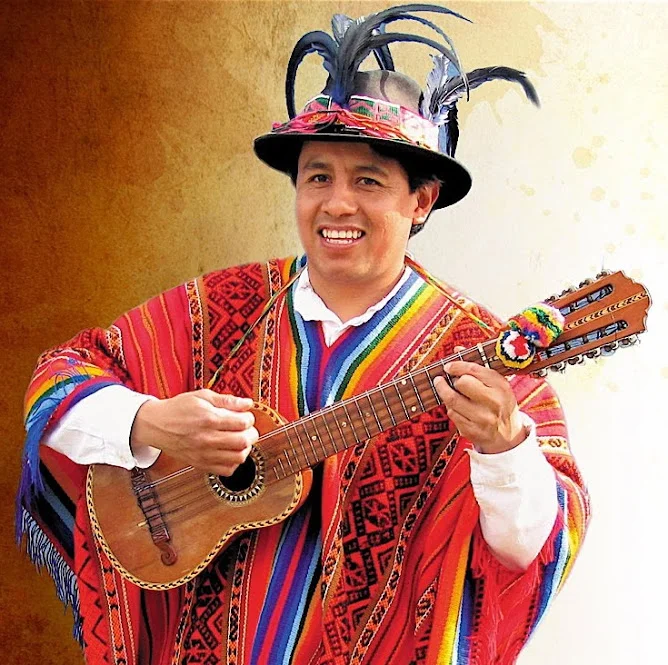 | Traditional skill/art/craft: Charango and Quena Instrument Making Years Awarded: 2012 Contact Information: Phone: (541)961-5186 Email: chayag2@yahoo.com Website: www.andeanmusic.org |
ARTIST BIOGRAPHY
I have played Andean Folk Music for the last 20 years of my life. I was inspired as a boy by my grandfather and the popular Andean folk groups of my native country, Ecuador. I later traveled the world sharing my music as part of the folk group Chayag. After coming to the U.S., I continued working in music. Through my performances I feel I’ve contributed to the cultural enrichment of our diverse society. As a boy, I remember going to my uncle’s in the summertime and working in his woodshop. I loved working with wood and as a musician I had to learn how to maintain and repair a diverse array of flutes and stringed instruments. This interest led me to begin making both bamboo and wood flutes and more recently to the construction of the ten-string Andean instrument, the charango.
APPRENTICE BIOGRAPHY - Freddy Calla Waywa 2012
Freddy Calla Waywa is from Telamayu, Bolivia, where he first learned Andean music during his village’s celebrations. Like many, he learned by ear and through the people around him and bought his first flute when he was 13. He then left to Mexico to learn natural medicine but continues to play music during that time, when he moved to the US he joined the Andean ensemble group Grupo Condor. He has been playing the flute for over 4o years, but this apprenticeship is his first opportunity to make instruments. His goal is to continue on the tradition and teach it to his sons, and possibly create workshops for others to participate. This apprenticeship will have Alex LLumiquinga teach Freddy how to construct a charango and a quena from bamboo.
Q+A WITH THE MENTOR ARTIST
Describe your traditional art.
Body
The Charango (ten stringed Andean Guitar) has been constructed traditionally using the armadillo shell but now is principally constructed from wood. Both the Charango and the bamboo flutes (including the Quena) are made to accompany all traditional festivities in communities, towns and cities across the Andean region. I began playing the instrument as a boy, and then as and adult became interested in learning how to make them.
How did you come to learn this tradition?
Body
I learned to make the Quena flutes in Ecuador in the year 2000 from Jaime Paredes. He mentored me on selecting the bamboo and tuning the flutes.
During the last decade I developed new flute making techniques that I have applied to many other types of Andean flutes such as the sampoña (also know as a panflute) and the river cane flute.
I began to think seriously about making my own Charango two years ago after getting inspired by a fellow luthier. I started reading and researching about the techniques of making this wonderful instrument.
My father bought me my first Charango when I was 12 from a neighbor who was a musician and instrument maker. It had the form of a panther carved on it. I love the instrument and I remembered spending some time working in a nearby shop helping finish stringed instruments. Today I have my own workshop in which I spend part of every day working on my Charangos. This enables me to continue the connection to my past and inspires me to further my knowledge of this craft which brings joy to my family, my friends, and my community.
Why is this cultural tradition important to your community?
Body
Music is the heart and soul of our culture. Through the centuries and millenia our people have shared the happiness and sadness of life through song. Despite a huge European influence on language and religion, our indigenous traditions and roots have sustained us and remain strong. Knowing how to make the traditional instruments allows us to continue to express our selves and teach our children something that is within all of us. Making and playing Andean instruments and traditional rhythms and songs is a way to connect with people from my part of the world, but also reach out and educate all who appreciate our culture.
Experience/Honors
Body
I have played Andean Folk Music for the last 15 years of my life. I was inspired as a boy by my grandfather and the popular Andean folk groups of my native country, Ecuador. I later traveled the world sharing my music as part of the music group Chayag.After coming to the US, I continued working in music. I am widely known as a musician in Lincoln county, Oregon where I have lived most of my time in the U.S. I participate in many local events every year including the summer library reading program and benefit programs for the community. I have also been a part of many cultural and educational programs all around the state. I also served in 2011 as an Artist in Residence at Lincoln Elementary in Corvallis where I taught a flute-making workshop to 60 second graders. In the fall of 2011, I had the honor of being invited to perform as part of the featured international music and dance music group at the United Tribes International Pow Wow in North Dakota. Through my performances I feel I’ve contributed to the cultural enrichment of our diverse society.Also, my four young children are growing up immersed in the music, and I hope they will continue to share and interpret the richness of their Andean heritage.
Visit OFN's Culture Keepers Roster to learn more about the artist.
Traditional Arts Apprenticeship Program
More OFN programs
OFN main page
